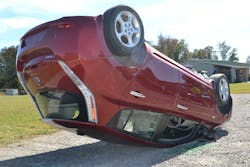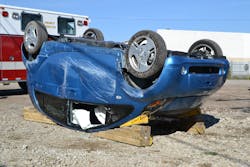University of Extrication: Electric Plug-In Vehicle Stabilization - Part 3
Topic: Electric Plug-In Vehicle (EV) Stabilization, Part 3
Objective: Accomplish effective stabilization of a roof-resting EV
Task: Given a roof-resting EV with a floorpan-mounted high-voltage lithium-ion battery, the rescue team shall recognize the unusual stabilization challenges and be able to effectively adapt their rescue and stabilization techniques accordingly.
The final part of this three-part series on Electric Plug-In Vehicle (EV) stabilization offers several stabilization tactics that can be used when an EV is encountered in a roof-resting position at an incident scene.
The Mitsubishi i-MiEV and the Nissan LEAF used for this research, like other similar EVs, have a very round, dome-shaped roof and a heavy floorpan-mounted high-voltage (HV) lithium-ion battery. When rolled into a roof-resting position, the rounded-roof Mitsubishi settled into an almost level, horizontal position. In contrast, the Nissan LEAF vehicle assumed a “front-end down” position.
During the research, two stabilization techniques were found to be effective for these EVs. A simple stabilization tactic using cribbing may be used, but using cribbing and struts is the recommended procedure, especially when more involved extrication work is anticipated.
All cribbing and struts were then removed, leaving the LEAF supporting itself as it rested on its roof. All the roof pillars on the driver’s side of the vehicle were cut through one at a time. As these cuts were being done, the vehicle sunk lower and lower with every pillar cut. Eventually, the EV dropped a total of 8 inches due to the weight of the HV battery pressing down on the structure of the vehicle.
Roof-resting EVs can be initially stabilized by wedging the front A-pillars and the rear C- or D-pillar and roofline area. With cribbing at the front, struts placed at the rear of the EV maintained good overall vehicle stability and allowed for unobstructed door access on both sides.
SIDEBAR
Considerations When Stabilizing a Roof-Resting EV
- EV rollover may assume a level position or a front-end down position
- Lithium-ion battery weight is significant
- Initial stabilization is possible with cribbing
- Strut stabilization from the rear may be necessary to minimize vehicle crushing
Read the rest of the series here:
Part 1: Floorpan-mounted batteries can cause challenges for rescuers
Part 2: Side-resting EVs present unusual stabilization challenges
About the Author
Ron Moore
RON MOORE, who is a Firehouse contributing editor, recently retired as a division chief with the McKinney, TX, Fire Department and now serves with Prosper, TX, Fire Rescue. He self-published the Vehicle Rescue 1-2-3 training manual and serves as the forum moderator for the extrication section of Firehouse.com . Moore can be contacted directly at [email protected].


